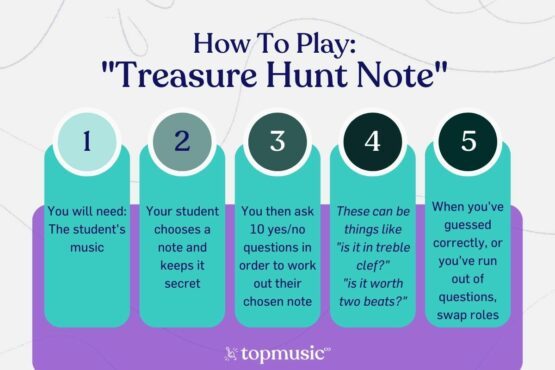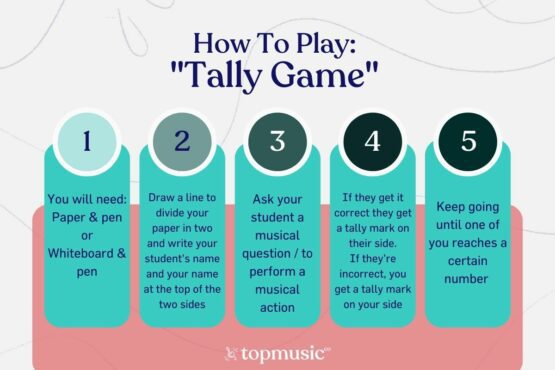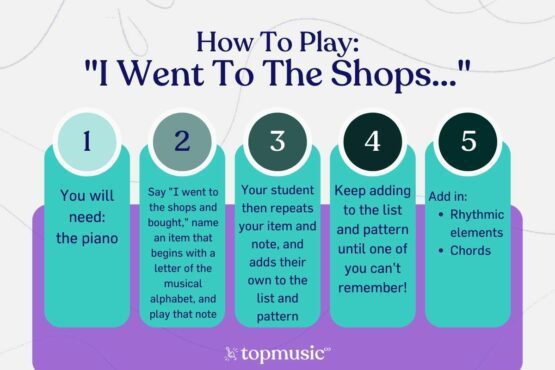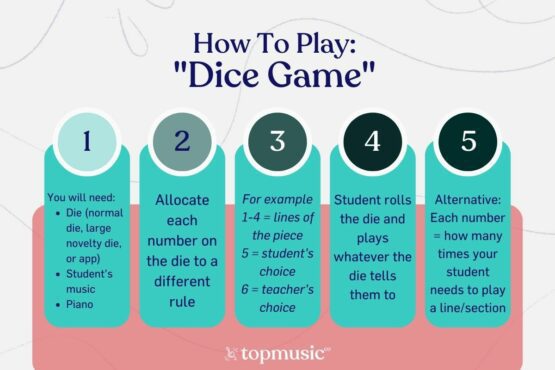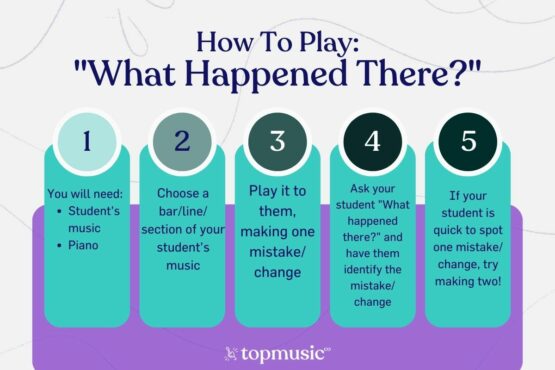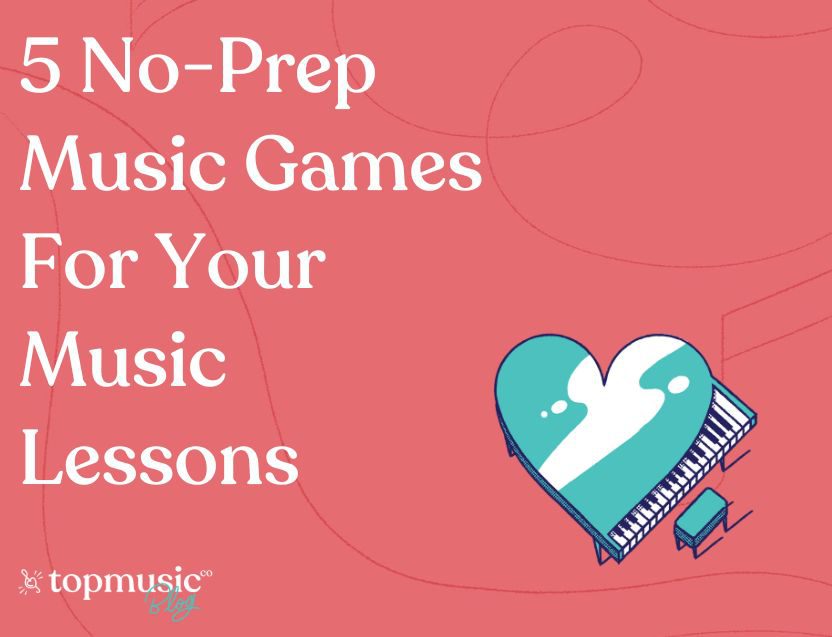Music games can be an absolute game-changer in music lessons. They can turn wiggling students into focused students. They can turn grumpy “Do I haaaaave toooooo?” students into excited and enthusiastic students. And they can even change “I don’t knowww” into “Oooh! I know the answer!”
But sometimes you need a music game that requires no (or very little) preparation that you can call on quickly.
Tara Wright (Melodic Mentors) and Georgina Wilson (BusyLittleTurtle) have five no-prep music games for you to add to your music teacher toolkit.
Table Of Contents:
- Treasure Hunt Note
- Tally Game
- I Went To The Shops…
- Dice Game
- What Happened There?
- More Music Games Please!
Georgina’s “Treasure Hunt Note”
This game gets your students really looking at their music!
You need:
How To Play:
- Your student chooses a note and keeps it secret. This is their treasure hunt note.
- You then ask 10 yes/no questions in order to work out their chosen note.
These can be questions like, “Is it in treble clef?” “Is the note worth four beats?”
- When you’ve guessed the note correctly or you’ve run out of questions, you swap roles. You pick a secret note, and your student has ten yes/no questions.
- If your student finds the treasure hunt note you can then ask them what their treasure would be (this is a great opportunity to get to know your student a bit more!)
This game works for students of all ages and abilities, and you can ask different types of questions to suit each student’s level.
Tara’s “Tally Game”
This one is super simple but super fun!
You need:
- Paper and pencil
- OR whiteboard and pen
How To Play:
- Draw a line in the middle of your page/whiteboard, diving it in two
- Write your student’s name at the top of one half and your name at the top of the other half
- Ask your student a musical question. It can be anything from asking what a note is in their music, asking them to identify an interval by ear, clapping you a rhythm… Absolutely anything!
- If they get it correct/perform the action correctly, they get a tally mark on their side
- BUT if they’re incorrect, you get a tally mark on your side
- Keep going until you reach a certain number (you can decide how long you want to play – first to five points, first to ten points, or even who can get the most points in a certain amount of time)
Students will try their absolute best to beat you – they don’t want you to win!
You can tailor this to different students and ask questions that you want them to really think about.
Georgina’s “I Went To The Shops…” Game
A musical take on a classic memory game that gets students laughing!
You need:
How To Play:
- You go first. Say, “I went to the shops and I bought…” then name an item that begins with a letter of the musical alphabet. Play that note on the piano. e.g. “I went to the shops and I bought a cat” and you play a C
- Your student then repeats, “I went to the shops and I bought a cat,” and plays a C. They then add another item that begins with a letter of the musical alphabet.
- Back to you – you say the first two items, play the first two notes, then add a third.
- Repeat, with the list of items and pattern of notes getting longer and longer until one of you can’t remember! (Or a pre-determined time runs out)
This is a super quick brain break that gets students working on piano key recognition. But you don’t just have to stop there!
This game is also great for older students if you add in extra rules:
- You have to play the rhythm of each item. For example ‘caterpillar’ would be four quick ‘C’s
- You have to add a descriptive word, so each person adds two notes to the pattern. For example ‘Blue Dress’. You could even play these as a chord, so your pattern of notes becomes a pattern of chords.
- Speaking of chords, you can have students play triads instead of single notes. You can agree to play all major or minor OR you add the word ‘happy’ or ‘sad’ to each item. For example, “Happy Cat” would be the C Major triad, whereas “Sad Bear” would be B minor.
Tara’s “Dice Game”
This game is perfect for students who need to work on their pieces but are getting a bit restless.
You need:
- Piano
- Student’s piece
- Die (can be a regular die, a giant novelty die, or even an app)
How To Play:
- Allocate each number on the dice to a different line (or section) in the piece or a rule
e.g. if the piece has four lines, 1-4 on the die is a different line. Five = student’s choice. Six = teacher’s choice.
Or if the student has two specific lines they need to work on, 1-3 = the first line, 4-6 = the second line.
- The student rolls the die and plays the line/section the dice has told them to play!
Alternative Way To Play:
- Choose a line/section of the student’s piece
- The number the student rolls is the number of times they play it in a row.
You will find that your students are more willing to listen to what the die tells them to do!
Georgina’s “What Happened There?” Game
A great way to test both how well your student knows their music and their listening skills!
You need:
How To Play:
- Choose a bar/line/section of the music
- You play it with a change/mistake. For example, missing out the F sharps, changing the rhythm, or playing the wrong dynamic.
- Ask your student to identify the mistake / change you made.
- When they’ve identified it, they play the bar/line/section in the correct way.
- If they’re doing well, step it up by making two mistakes/changes and see if they can point out both of them.
This is great if you have a student who keeps making the same error no matter how many times you point it out! For example, they keep counting to two on the four-beat notes. If you play it and emphasize your incorrect counting and ask them what you were doing wrong, hopefully they’ll be able to point out you were only counting to two. Then when you ask them to play the correct version hopefully they’ll get the counting right!
More Music Games Please!
Looking for more fun music games to play in your music lessons? Look no further!
TopMusicPro is excited to announce the launch of TopMusicGames!
Every month, every member of TopMusicPro gets four brand-new games to play with their students!
